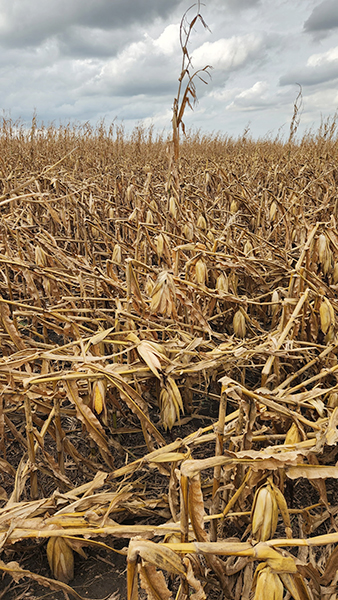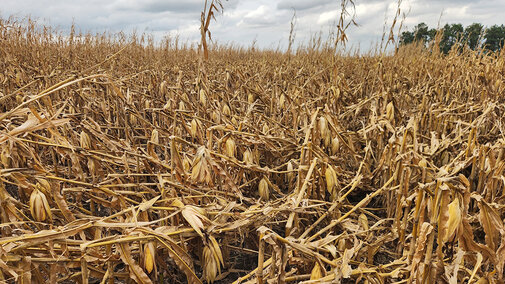Key Takeaways
Watch moisture: Stress can trigger premature black layer and faster drydown — check often, especially for silage and high-moisture corn.
Check stalk strength: Use push or pinch tests; if many fail, move those fields up in the harvest order.
Manage lodged/hail-hit fields: Harvest a bit wetter and run slow, single-direction passes against the lean.
Protect kernel quality: Smaller or brittle kernels crack easier — tune header and separator settings to cut losses.
Handle problem grain smartly: Don’t blend ear-rot or moldy grain — dry to ~14% and cool quickly; use or market it first.
Safety first: Air can be “dusty” with spores — wear a respirator, check equipment air filters, keep extinguishers handy.
Unusual growing conditions and increased disease pressure in 2025 could have longer lasting and unexpected impacts for harvest and other activities. This list is intended to raise awareness about potential related complications that may occur in your fields and how you can monitor, prepare and minimize losses during and approaching harvest.
Rapid Senescence and Drydown
Upon reaching physiological maturity (black layer), most corn hybrids are around 30% moisture. The average corn drydown for hybrids reaching maturity in late August is around 0.8 percentage point per day and 0.4 percentage point per day for hybrids reaching maturity in mid-September. High heat and wind, such as we experienced in September 2024, can lead to well over 1.0 percentage point per day in dry down.
Corn diseases — such as southern rust, tar spot and others that have been more common this year — combined with hail damage and lodging due to storms can accelerate senescence and drying of corn. Hybrids have varied in how they handled these pressures. Sometimes these pressures lead to premature death of plants, including the premature formation of black layer. When that happens, grain drying occurred earlier than anticipated with a higher drydown rate per day than if the grain had matured normally.
- Key Point: Monitor the moisture content of grain in fields with heavy disease pressure and/or storm damage NOW. This is especially important if you plan to chop corn for silage or high moisture corn for feed to avoid missing target moisture stages for harvest.

Weaker Cornstalks
Crop stress during 2025, especially diseases and less favorable growing conditions, have led to development of stalk rot diseases and generally weak stalks in many fields. You can determine the risk for corn lodging in each of your fields with the “push or pinch” tests.
- Push test: Push at least 100 corn plants to arm’s length about 30 degrees from vertical. If plants bend below the ear and don’t snap back upright, they have a greater chance of lodging at or prior to harvest if there’s high wind events or heavy rain. When more than 10% of plants fail the test, you should consider harvesting early, or harvesting the highest risk fields earlier in your harvest order.
- Pinch test: Squeeze the lower internodes to assess stalk strength and check for stalks that are easily crushed by hand.

Storms and Hail Damage
Furthermore, hail damage and storms that caused severe lodging in some parts of the state (during mid-August 2025) have shortened the grain filling period. Hail damage and lodging in corn causes reduced photosynthesis, vascular disruption, hormonal stress and increased disease pressure. The crop therefore has “matured” faster, necessitating early harvest to minimize further yield loss.
- Hail strips plant leaves, reducing the photosynthetic area. This causes the plant to remobilize stored carbohydrates from stalks and leaves to the ear, accelerating development and dry down, which reduces time to physiological maturity. Hail can also cause stalk bruising and wounding, which weaken stalk tissues and predispose it to stalk rots and lodging. The wounds on the corn ear (tips) can provide entry points for fungal pathogens (e.g., Fusarium, Diplodia) that further affects grain quality.
- Corn may be lodged, leaning and/or broken from storm damage as well. Lodged/leaning plants will still fill the ears but may result in lighter kernel weights and lower test weights. Aim to start harvesting these fields at a higher moisture (above 17%) — and harvest these fields first, as they will be slow. For entire fields that are lodged, growers found harvesting one way against the lodged plants allowed the greatest success of picking up the plants without ears snapping off and/or plugging the combine. Iowa State University offers additional tips on harvesting lodged corn.
Smaller Kernels and Grain Quality Concerns
Loss of leaf area due to diseases, hail, etc. reduces plant photosynthesis and impacts kernel development. These effects can reduce yield but also reduce kernel size and test weight. Kernel damage caused by insect feeding, hail, wet conditions and micro-climate caused by lodged plants may also lead to development of ear rot and grain mold diseases.
- Impacted kernels may be smaller and/or more brittle and prone to breaking during harvest and handling. Adjust combine settings to reduce losses during harvest if your corn kernels (or cobs) are smaller or brittle. Also, aim to harvest grain at a higher moisture (over 17%) to reduce kernel loss.
- Grain that has reduced quality or ear rot diseases should not be mixed in storage with higher quality grain, as fungi usually continue to grow in storage. To help reduce fungal growth in storage, grain should be dried to 14% and cooled as soon as possible. Grain affected by ear rot diseases and mold are less suitable for storage. Use or sell affected grain first and store the highest quality corn possible.
‘Dusty’ Conditions May Reduce Air Quality
Increased corn disease pressure caused by fungi can lead to large amounts of fungal spores circulating in the air over corn fields, especially during harvest. Fungal spores may behave like dust or other particulate matter and aggravate respiratory illness or symptoms in sensitive individuals.
- Consider wearing dust masks or respirators when working in affected fields or around grain, such as in grain bins.
- It may also be important to repeatedly check air filters on equipment operating in conditions with a lot of dust and spores.
Safety
With these challenges in mind as combines start rolling, we hope everyone has a safe harvest season. Be sure to keep fire extinguishers close at hand. Take breaks as needed — especially producers harvesting downed corn, as it will be challenging, tedious work — and care for your mental, emotional and physical well-being.
- The Nebraska Rural Response Hotline is 800-464-0258 and is available for emotional support, legal and financial assistance, and disaster relief.
- If illness, injury or disaster hits, Farm Rescue volunteer crews and equipment can help farm families in crisis finish harvest. Learn more about their services and apply online.
- Fire safety tips for harvest are available on CropWatch.
Resources
- Bergman, Ryan W., Aaron Saeugling, Shawn Shouse, Kristina TeBrockhorst, Mark Hanna. August 21, 2020. Combine Adjustments for Harvesting Lodged Corn. https://crops.extension.iastate.edu/post/combine-adjustments-harvesting-lodged-corn
- Darr, Matt and Ben Covington. Sept. 25, 2020. Video: Tips for Harvesting Downed Corn, https://crops.extension.iastate.edu/post/video-tips-harvesting-downed-corn
- Nielsen, R.L. (Bob), September 2018. Field Drydown of Mature Corn Grain. https://www.agry.purdue.edu/ext/corn/news/timeless/GrainDrying.html
- Timmerman, Amy. October 2, 2024. Fire Safety During Harvest Season: Essential Tips for Farmers, https://cropwatch.unl.edu/2024/fire-safety-during-harvest-season-essential-tips-farmers/

